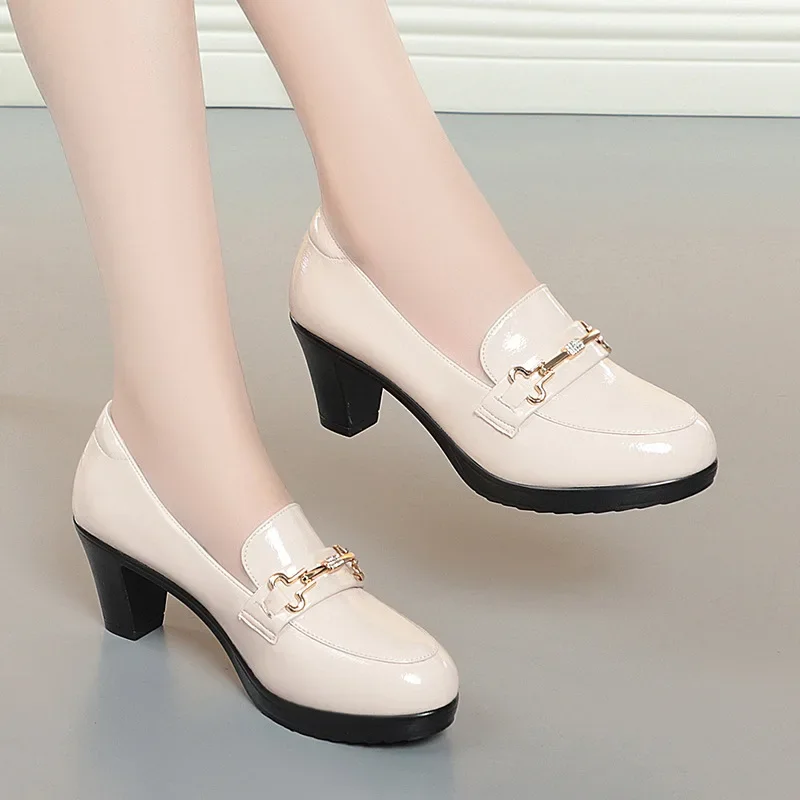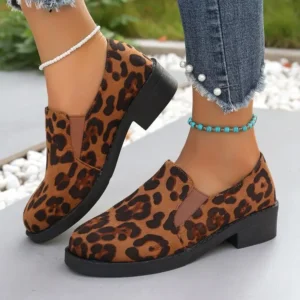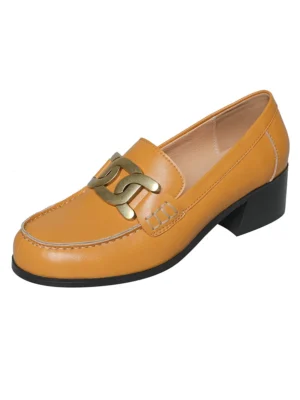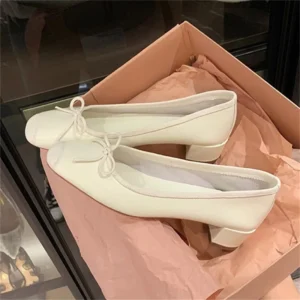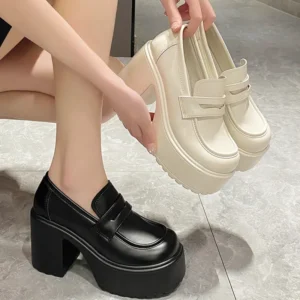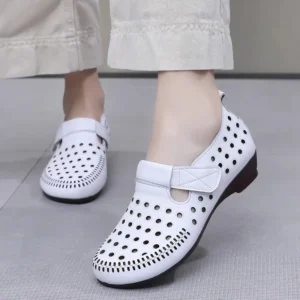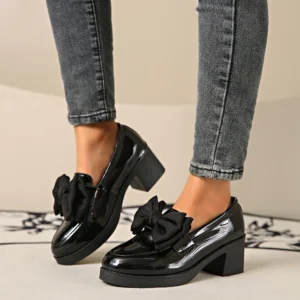Understanding Block Heels and Foot Health: The Basics
Block heels have become a popular footwear choice for many women seeking style with a bit more stability. Unlike their slender stiletto counterparts, block heels feature a wider base that extends fully from the back of the shoe, creating a sturdier foundation. This distinctive design distributes weight more evenly across a larger surface area.
So, are block heels good for your feet? The short answer is that block heels are generally better for foot health than stilettos, but they still present potential issues for foot health. While they offer improved stability and pressure distribution compared to narrower heels, they still alter your natural foot position and walking mechanics.
What makes footwear “good” for your feet depends on multiple factors: the heel height (which typically ranges from 1-4+ inches), specific design features, how frequently you wear them, and your individual foot structure and conditions. Someone with existing foot problems may experience different effects than someone with healthy feet.
When considering stylish yet practical options for professional environments, many women find that professional office loafer outfits can provide a comfortable alternative that still delivers sophisticated style. However, understanding the specific impacts of block heels on foot health can help you make more informed choices about when and how to wear them.
The Biomechanics: How Block Heels Affect Your Feet
To truly understand whether block heels are good for your feet, we need to examine what happens biomechanically when you wear them.
Weight Distribution
Block heels distribute body weight differently than flat shoes. Even with their wider base, they still shift your weight forward, increasing pressure on the ball of your foot. However, research shows that block heels create approximately 20-30% less forefoot pressure than stilettos of the same height, which is a significant improvement.
Stability and Balance
The defining feature of block heels—their wider base—provides substantially better stability than narrower heels. This broader foundation reduces ankle wobbling and decreases the risk of falls or sprains, especially on uneven surfaces or when walking for longer periods.
Altered Foot Posture
Any elevated heel changes your foot’s natural alignment. As heel height increases, your ankle flexes, pushing your foot into an unnatural downward position. This shifts your center of gravity forward and forces other body parts to compensate.
Changed Walking Mechanics
Block heels alter your normal gait pattern by shortening your stride and changing knee and hip movements. Your calf muscles remain in a more contracted position, and over time, this can lead to muscle imbalances and potential shortening of the Achilles tendon.
If you’re curious about how different heel types compare, exploring whether wedge heels are good for feet can provide additional context for understanding footwear impacts on foot health.
Benefits of Block Heels: Why They Can Be a Better Choice
When considering heel options, block heels offer several advantages that make them a healthier choice than many alternatives:
Enhanced Stability: The wider heel base provides significantly better balance and reduces the risk of ankle rolls or falls, making them a safer option for daily wear.
Better Weight Distribution: Block heels spread pressure across a larger surface area, reducing the intensity of pressure points on the ball of the foot compared to stilettos.
Increased Wearing Comfort: Many wearers find they can tolerate block heels for longer periods due to the improved stability and reduced strain on the foot’s structure.
Versatile Height Options: Block heels come in various heights, from very low (1 inch) to high (4+ inches), allowing you to choose options that better accommodate your comfort needs and foot health.
Transitional Benefit: For those trying to move away from high, narrow heels but not ready to give up height entirely, block heels offer a middle-ground option that’s more foot-friendly.
Podiatrists often recommend block heels over stilettos when patients insist on wearing heels, particularly highlighting that wider heels under 2 inches high cause the least disruption to natural foot mechanics. For a stylish yet supportive option, many women find that women’s block heel loafers offer a good balance between fashion and foot health.
Potential Risks and Foot Problems: The Downside of Block Heels
Despite their advantages over stilettos, block heels still present several potential foot health concerns:
Forefoot Pressure and Metatarsalgia
Even with improved weight distribution, block heels still force more pressure onto the ball of the foot. This increased pressure can lead to metatarsalgia—pain and inflammation in the metatarsal region—characterized by sharp, aching or burning pain in the ball of the foot.
Toe Box Issues
Many heeled shoes, including some block heels, feature narrow toe boxes that compress the toes. This compression can contribute to or worsen:
- Bunions: Painful bony protrusions at the base of the big toe
- Hammertoes: Abnormal bends in the toe joints
- Corns: Painful hardened areas of skin caused by friction and pressure
Achilles Tendon and Calf Issues
Regular wear of any heeled shoe keeps the calf muscles and Achilles tendon in a shortened position. Over time, this can lead to:
- Reduced flexibility in the ankle joint
- Achilles tendon shortening and tightness
- Increased risk of tendon injury when wearing flat shoes
Posture and Alignment Changes
Block heels alter your body’s natural alignment, affecting:
- Forward tilt of the pelvis
- Increased curve in the lower back
- Knee joint stress from changed angle
- Compensation patterns throughout the spine
For those concerned about these issues but still wanting a fashionable option, women’s square heel loafers sometimes offer a slightly different pressure distribution pattern while maintaining a similar aesthetic.
Block Heels vs. Other Shoe Types: A Comparison
Understanding how block heels compare to other footwear options helps put their foot health impact in context:
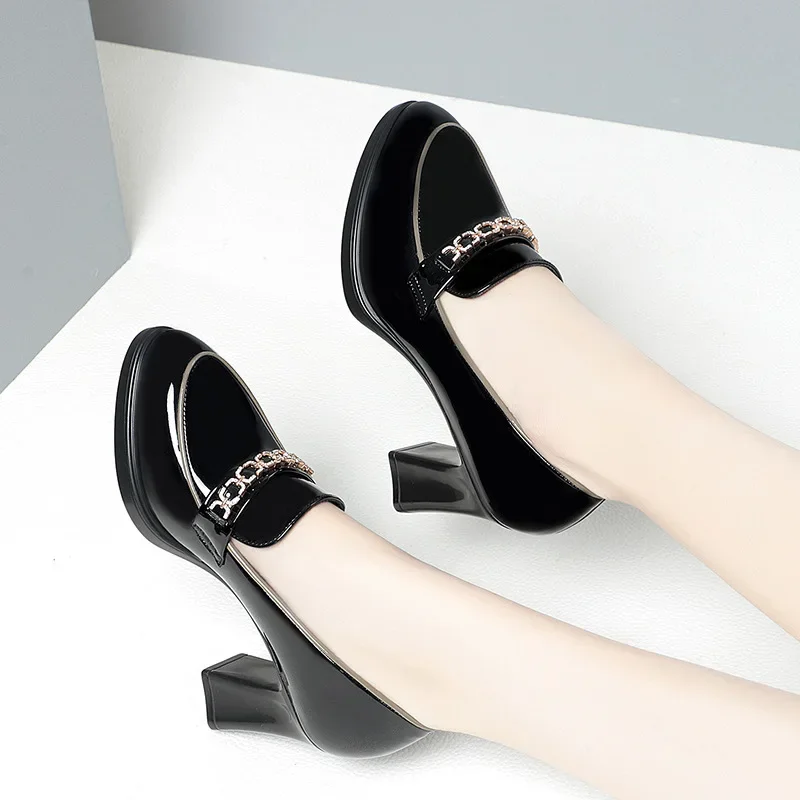
Block Heels vs. Stilettos
- Stability: Block heels provide significantly better stability, reducing ankle strain and fall risk.
- Pressure Distribution: Block heels spread weight across a wider area, while stilettos concentrate extreme pressure on a small point.
- Comfort: Most people can wear block heels comfortably for longer periods.
- Foot Health Impact: Both raise the heel and shift weight forward, but stilettos create more extreme pressure points and instability.
Block Heels vs. Wedges
- Support Pattern: Wedges provide continuous support under the arch, while block heels leave the arch unsupported.
- Flexibility: Block heels allow more natural foot flexion than most wedges.
- Stability: Wedges generally offer slightly more stability due to their larger base.
- Weight: Wedges typically weigh more, potentially causing more foot fatigue.
Block Heels vs. Kitten Heels
- Height: Kitten heels are typically lower (1-2 inches), creating less postural change.
- Impact on Gait: Both alter walking mechanics, but kitten heels cause less disruption.
- Pressure Distribution: Both styles shift weight forward, but kitten heels create less intense forefoot pressure due to lower height.
Block Heels vs. Flats
- Arch Support: Quality block heels sometimes offer better arch support than completely flat shoes.
- Impact Absorption: Some block heels provide better shock absorption than thin-soled flats.
- Natural Foot Position: Flats maintain a more natural foot alignment and walking pattern.
When considering workplace footwear options, many professionals weigh the differences between loafers vs heels for professional footwear to find the right balance of comfort and style.
Choosing Foot-Friendly Block Heels: What to Look For
If you choose to wear block heels, selecting the right design features can significantly minimize their potential negative impacts:
Optimal Heel Height
Podiatrists generally recommend staying under 2 inches for everyday wear. This lower height causes less dramatic changes to your foot position and walking mechanics while still providing some height.
Heel Width and Stability
Look for a substantially wide heel base that provides maximum stability. The wider the heel relative to its height, the more stable the shoe will be.
Platform Consideration
A slight platform under the toe area reduces the actual angle of the foot by raising the front portion. This creates a more gradual incline and can significantly reduce forefoot pressure.
Cushioning and Materials
Seek out:
* Memory foam or gel padding under the ball of the foot
* Shock-absorbing materials in the sole
* Soft, flexible uppers that don’t restrict foot movement
* Breathable materials that reduce moisture and friction
Toe Box Design
Choose shoes with:
* Rounded or square toe boxes rather than pointed
* Sufficient width to allow toes to spread naturally
* Enough depth to prevent top-of-foot pressure
Proper Fit Guidelines
- Shop for shoes in the afternoon when feet are naturally more swollen
- Ensure at least 3/8-inch space beyond your longest toe
- Make sure the widest part of your foot aligns with the widest part of the shoe
- Feel for any pressure points or pinching before purchasing
For those seeking a more foot-friendly option with some elevation, women’s low heel loafers often provide a good compromise between style and comfort.
Block Heels and Specific Foot Conditions: What You Need to Know
Different foot conditions may require specific considerations when wearing block heels:
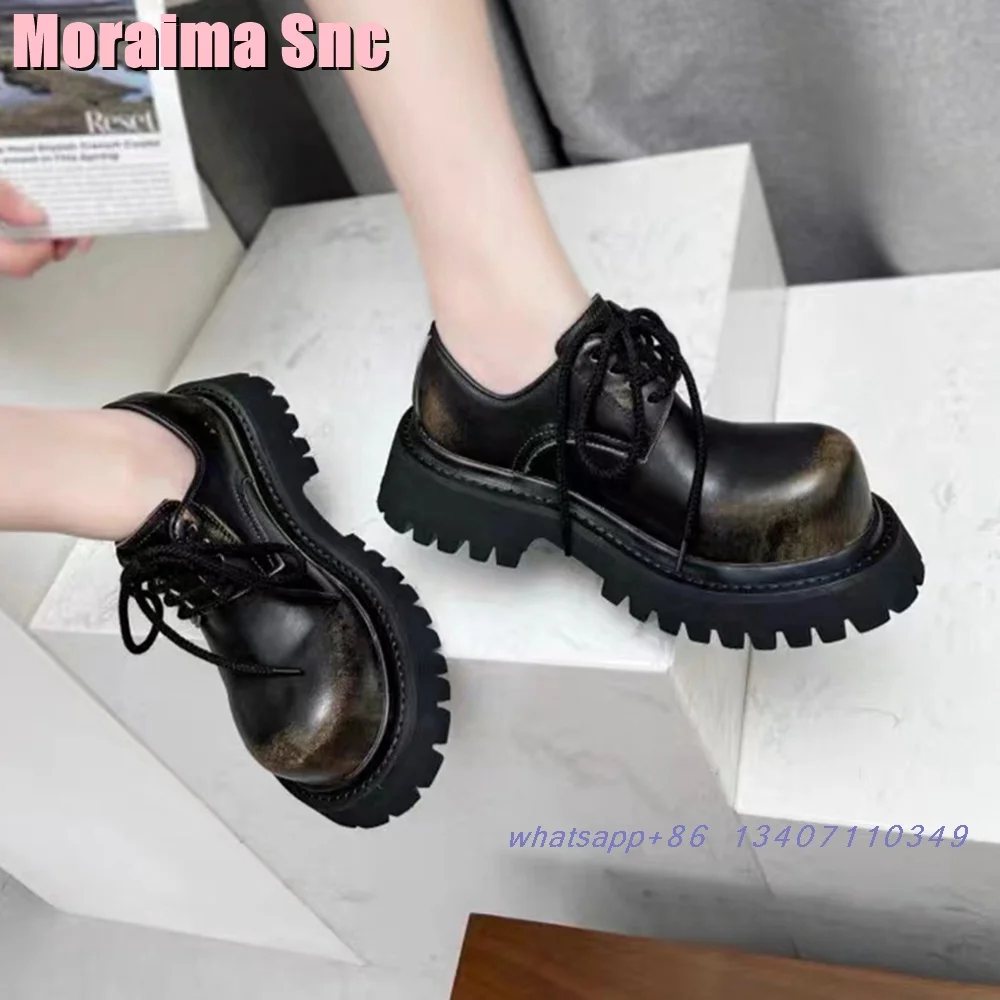
Plantar Fasciitis
This painful inflammation of the fascia connecting your heel to toes can be aggravated by heels. If you have plantar fasciitis:
* Opt for very low block heels (under 1.5 inches)
* Ensure excellent arch support
* Add cushioned inserts specifically designed for plantar fasciitis
* Consider limiting heel wear during flare-ups
Bunions
The pressure and toe box shape of many heeled shoes can worsen bunions:
* Choose styles with wide, rounded toe boxes
* Avoid shoes that put pressure on the bunion area
* Look for soft, stretchable upper materials
* Consider shoes specifically designed to accommodate bunions
Metatarsalgia
For this ball-of-foot pain:
* Select lower heels with excellent forefoot padding
* Add metatarsal pads to redistribute pressure
* Choose styles with built-in cushioning under the ball of the foot
* Consider limiting block heel height to 1 inch or less
Hammertoes
To prevent aggravating hammertoes:
* Ensure adequate toe box height and width
* Avoid styles that push toes forward into the front of the shoe
* Look for soft, flexible materials that won’t create friction on the tops of toes
Understanding these considerations can help you make better choices about footwear for specific environments, such as how to wear loafers to the office with maximum comfort.
Beyond Your Feet: How Block Heels Impact Your Whole Body
The effects of wearing block heels extend well beyond your feet, influencing your entire musculoskeletal system:
Knee Impact
Block heels increase pressure on the inner sides of the knees, potentially contributing to knee pain or even accelerating wear in the knee joint over time. Research shows that walking in heels higher than 2 inches increases knee joint torque by approximately 23%.
Hip Alignment
The forward shift in posture from wearing heels changes hip positioning, which can increase pressure on the hip joints and potentially contribute to hip pain or altered movement patterns.
Lower Back Effects
To maintain balance with the forward shift created by heels, the lower back often increases its natural curve (lordosis). This altered position can contribute to lower back strain, muscle tightness, and potentially chronic pain over time.
Overall Postural Changes
Wearing block heels regularly can lead to:
* Forward head posture
* Increased tension in neck and shoulder muscles
* Shortened hip flexors
* Altered walking patterns that may persist even in flat shoes
While block heels create less dramatic changes than stilettos, the body still needs to compensate for the unnatural position. For those seeking footwear that combines professional appearance with comfort, exploring options for all-day comfort without sacrificing style can help minimize these whole-body impacts.
Strategic Wearing: How to Enjoy Block Heels with Minimal Risk
With thoughtful strategies, you can enjoy wearing block heels while minimizing potential foot health issues:
Implement the 70/30 rule: Wear heels no more than 30% of your day, switching to supportive flats for the remainder.
Match heel height to occasion: Save higher heels for short-duration events while opting for lower, more stable options for all-day wear.
Listen to your body’s signals: Remove heels at the first sign of pain rather than pushing through discomfort.
Use supportive inserts strategically: Add metatarsal pads, heel cups, or other specialized inserts to address specific pressure points.
Maintain proper fit: Replace shoes when they show signs of wear that affect their support and stability.
Employ the commuter switch: Wear comfortable shoes for commuting and change into heels only when necessary.
Build tolerance gradually: If you’re new to block heels, start with short wearing periods and gradually increase as your feet adapt.
Women's Comfortable Flat Loafers, Women's Leopard Print Loafers, Women's Low Heel Loafers
$82.50 Select options This product has multiple variants. The options may be chosen on the product pageWomen's Block Heel Loafers, Women's Heeled Penny Loafers, Women's Monk Strap Loafers
$194.04 Select options This product has multiple variants. The options may be chosen on the product pageWomen's Block Heel Loafers, Women's Square Heel Loafers, Women's Square Toe Flat Loafers
Price range: $73.61 through $86.41 Select options This product has multiple variants. The options may be chosen on the product pageWomen's Black Platform Loafers, Women's High Heel Loafers, Women's High Platform Loafers, Women's White Platform Loafers
$106.67 Select options This product has multiple variants. The options may be chosen on the product pageWomen's Comfortable Flat Loafers, Women's Leather Flat Loafers, Women's Round Toe Flat Loafers
$124.88 Select options This product has multiple variants. The options may be chosen on the product pageWomen's Black Heeled Loafers, Women's Black Platform Loafers, Women's Block Heel Loafers, Women's Chunky Heel Loafers
$72.58 Select options This product has multiple variants. The options may be chosen on the product page
For those seeking versatile options that work with various outfits, women’s heeled loafers can offer a comfortable middle ground that works well with strategic wearing plans.
Essential Exercises and Care for Block Heel Wearers
Counteract the effects of wearing block heels with these targeted exercises and care routines:
Calf and Achilles Stretches
Wall Stretch: Stand facing a wall with one foot forward and one back, keeping the back leg straight with heel on the ground. Lean forward until you feel a stretch in the back calf. Hold 30 seconds, repeat 3 times per side.
Step Stretch: Stand on a step with heels hanging off the edge. Lower heels below the step level and hold for 15-30 seconds.
Toe and Foot Exercises
Toe Spreading: While seated, spread toes wide apart, hold for 5 seconds, and release. Repeat 10 times.
Towel Scrunches: Place a small towel on the floor and use your toes to scrunch it toward you. Repeat 10-15 times per foot.
Foot Massage and Release
Roll a tennis ball or frozen water bottle under the arch and ball of your foot for 2-3 minutes per foot.
Use thumb pressure to massage the arch and ball of the foot after removing heels.
Ankle Strengthening
Ankle Circles: Rotate each ankle slowly in both directions, 10-15 circles each way.
Single-Leg Balance: Practice standing on one foot for 30 seconds at a time to improve ankle stability.
Integrating these practices with proper footwear selection, like those outlined in the ultimate guide to women’s loafers for the office, can help maintain foot health while still enjoying fashionable options.
FAQ: Common Questions About Block Heels and Foot Health
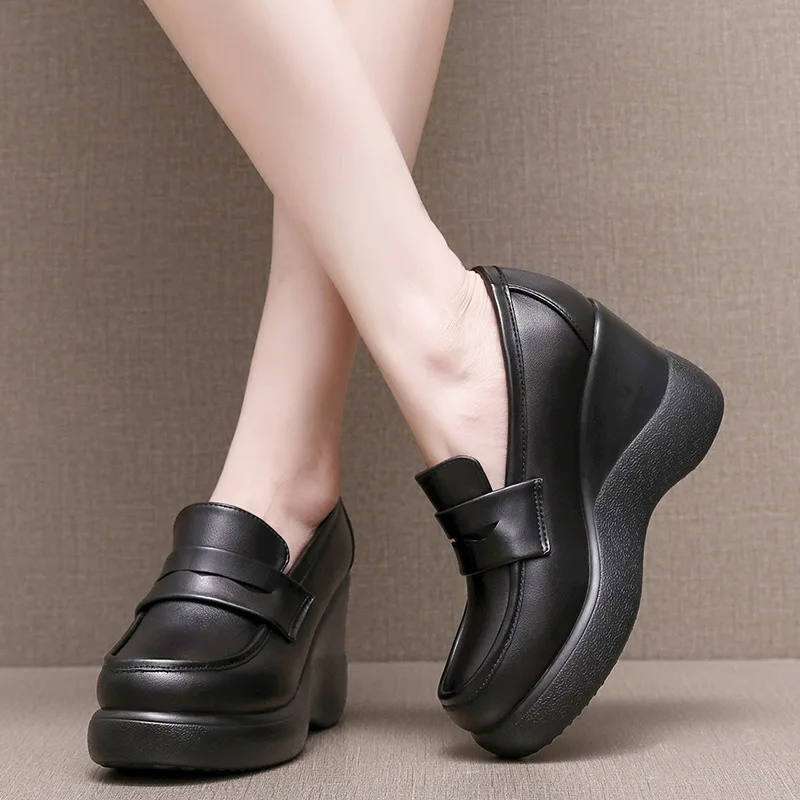
Are block heels truly safer than stilettos?
Yes, block heels are generally safer than stilettos due to their wider base, which provides better stability and reduces the risk of ankle injuries. They also distribute weight more evenly, creating less extreme pressure on the ball of the foot. However, they still alter natural foot mechanics and can cause issues if worn excessively.
What is the maximum heel height that’s considered “safe”?
Most podiatrists recommend staying under 2 inches for regular wear. Beyond this height, significant changes occur in your walking mechanics and pressure distribution, regardless of heel type. For occasional wear, keeping heels under 3 inches helps minimize risks.
Can block heels cause bunions?
Block heels themselves don’t directly cause bunions, but they can contribute to their development or worsen existing ones, especially if the toe box is narrow or pointed. The forward pressure from any heel pushes the toes into the front of the shoe, potentially exacerbating bunion formation in those with genetic predisposition.
Are block heels appropriate for people with flat feet?
People with flat feet should approach block heels cautiously. While the added stability of block heels is helpful, flat feet typically need good arch support, which many heeled shoes lack. If you have flat feet and want to wear block heels, look for styles with built-in arch support and keep heel height minimal.
How can I make my block heels more comfortable?
Add cushioned insoles designed for heels, use ball-of-foot pads to reduce pressure points, ensure proper fit with no slipping or pinching, break shoes in gradually before extended wear, and consider stretching services for tight areas.
When to Skip the Heels: Recognizing No-Go Scenarios
Despite their relative advantages over other heel types, there are situations when it’s best to avoid block heels entirely:
Foot Deformities
If you have moderate to severe hammertoes, advanced bunions, or significant toe deformities, even block heels may exacerbate pain and progression of these conditions. In these cases, wide-toe-box flat shoes are generally a better option.
Recent Injuries
Ankle sprains, stress fractures, tendonitis, or plantar fasciitis flare-ups require proper support and natural foot positioning to heal. Wearing any heel during recovery can delay healing and potentially worsen the injury.
Balance and Stability Concerns
Those with neurological conditions affecting balance, seniors with stability issues, or anyone with proprioception problems should generally avoid elevated heels to reduce fall risk.
Foot Pain
If you consistently experience pain while wearing block heels or pain that persists after removing them, this is your body’s signal that this footwear choice is causing damage. Persistent pain requires evaluation by a podiatrist.
Long Walking Distances
Even the most comfortable block heels aren’t designed for extensive walking or standing. For commuting, touring, or active days, women’s comfortable flat loafers provide a stylish alternative that won’t compromise foot health.
A Balanced Approach: Finding Your Foot-Friendly Style
When it comes to block heels and foot health, balance is key. Block heels can be a reasonable compromise between fashion and function when chosen carefully and worn strategically. They offer distinct advantages over stilettos in terms of stability and comfort, but still present some of the same biomechanical challenges as any heeled shoe.
The most foot-friendly approach is to build a versatile wardrobe that doesn’t rely exclusively on heels. Alternating between different heel heights and flat shoes helps prevent overuse issues and gives your muscles and tendons time to recover between wearings.
Remember that foot health is highly individual—what works comfortably for one person may cause problems for another. Pay attention to how your feet feel during and after wearing block heels, and adjust your choices accordingly. By prioritizing proper fit, moderate heel heights, and supportive features, you can enjoy the style of block heels while minimizing their impact on your long-term foot health.
At Artisan Haul, we believe that fashion and comfort can coexist. The right pair of block heels—worn mindfully—can be part of a foot-healthy wardrobe that supports both your style preferences and your body’s needs.

